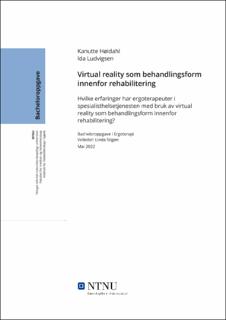| dc.contributor.advisor | Stigen, Linda | |
| dc.contributor.author | Høidahl, Kanutte | |
| dc.contributor.author | Ludvigsen, Ida | |
| dc.date.accessioned | 2022-07-02T17:19:39Z | |
| dc.date.available | 2022-07-02T17:19:39Z | |
| dc.date.issued | 2022 | |
| dc.identifier | no.ntnu:inspera:106253888:111011550 | |
| dc.identifier.uri | https://hdl.handle.net/11250/3002360 | |
| dc.description.abstract | Tittel: Virtual reality som behandlingsform innenfor rehabilitering Dato: 09.05.2022
Forfattere: Kanutte Høidahl og Ida Ludvigsen
Veileder: Linda Stigen
Stikkord/nøkkelord: Ergoterapi, Virtual reality (VR), rehabilitering, spesialisthelsetjenesten og Canadiske modell for aktivitetsutførelse og engasjement (CMOP-E)
Antall ord: 9308 Antall vedlegg: 7 Antall sider: 51
Bakgrunn: Bakgrunnen for forskningen er virtual reality som behandlingsform innenfor rehabilitering i spesialisthelsetjenesten. Det er blitt tatt i bruk fem fagfellevurderte forskningsartikler som presenterer ulike erfaringer med temaet.
Hensikt: Hensikten med denne forskningen er å undersøke hvilke erfaringer ergoterapeuter i spesialisthelsetjenesten har med bruk av VR som behandlingsform innen rehabilitering. Den innsamlede dataen vil også knyttes opp mot tidligere forskning.
Metode: Dette er en kvalitativ forskningsstudie hvor det ble utført litteratursøk i tre databaser, og semistrukturerte individuelle intervjuer for å samle inn data.
Resultat: Virtual reality er et frivillig behandlingstilbud som komplementerer konvensjonell behandling. VR som behandlingsform har blitt en kjent måte å trene på innenfor rehabiliteringstjenesten. Både pasienter og ergoterapeuter opplever VR som motiverende og morsom måte å trene på.
Konklusjon: Bruk av virtual reality som behandlingsform er motiverende og engasjerende både for pasienter og ergoterapeuter. For fremtidig implementering av VR er opplæring en svært viktig del.
Kombinasjon av VR og konvensjonell rehabilitering kan bidra til å oppnå målsetting, og best mulig utbytte av treningen. | |
| dc.description.abstract | Title: Virtual reality as a form of treatment within rehabilitation Date: 09.05.2022
Participants: Kanutte Høidahl og Ida Ludvigsen
Supervisor: Linda Stigen
Keywords: Occupational therapy, Virtual reality (VR), rehabilitation, specialist health service and The Canadian Model of Occupational Performance and Engagement (CMOP-E)
Number of words: 9308 Number of attachments: 7 Number of pages: 51
Background: The background for the task is virtual reality as a form of treatment within rehabilitation in the specialist health service. Five peer- reviewed articles that presents different experiences with the topic have been used and included.
Purpose: The purpose with this task is to investigate the experiences of occupational therapists in the specialist health service with the use of VR as a form of treatment in rehabilitation. The collected data will also be linked to previous scientific studies.
Method: This is a qualitative research study where literature searches have been performed in three databases, and semistructured individual interviews to collect data.
Result: Virtual reality is a voluntary treatment offer that complements conventional treatment. VR as a form of treatment has become a well-known way of training in the rehabilitation service. Both patients and occupational therapists experience VR as a motivating and fun way to exercise.
Conclusion: The use of virtual reality as a form of treatment is motivating and engaging for both patients and occupational therapists. For future implementation of VR, teaching is a very important part. The combination of VR and conventional rehabilitation can contribute to achieving goals, and the best possible dividend from the training. | |
| dc.language | nob | |
| dc.publisher | NTNU | |
| dc.title | Virtual reality som behandlingsform innenfor rehabilitering | |
| dc.type | Bachelor thesis | |
